‘I have humbled the Devas but exhausted my spiritual powers.’ That’s the rishi Vishwamitra having selflessly sacrificed his hard-won punya in order to raise the maimed King Trishanku to heaven against the wishes of the Devas. (OK, he says that in the Amar Chitra Katha comicbook adaptation of his deeds, which is no guarantee that he actually said it, but that’s the medium via which ArtReview Asia gets its religious knowledge, as it’s basically a visually led entity, so…). In any case, something similar could be said by ArtReview Asia after it examines its own depleted punya once it has received, digested and parsed the ever-increasing litany of events that surround Art Basel’s annual Hong Kong jamboree so that you don’t have to sully yourselves by foolishly going to art exhibitions that suck (for let’s face it, much as ArtReview Asia loves anything that has art in its name – itself most of all – and anything done in the name of art, not all of it is good). And yes, it’s that time again. Here’s ArtReview Asia’s punya getting chucked into the flames (a 12-month yoga retreat gone to waste!), so that whatever meagre store you retain can remain intact.
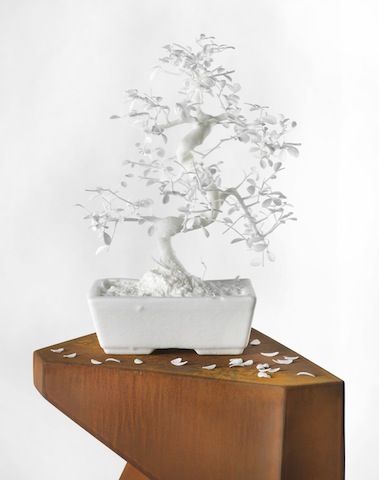
Rirkrit Tiravanija, Art Basel Hong Kong, 23–25 March
In fact, you might want to up your punya content by starting your visit to Honkers with a trip to Rirkrit Tiravanija’s project in Art Basel Hong Kong’s Encounters section (largescale works dotted around the fair). A spiritual affair, Tiravanija’s project comprises a maze constructed of traditional bamboo scaffolding within which viewers encounter five iterations of a 3D-printed bonsai tree (in varying states of leafiness) placed atop steel plinths that look like wooden geometrical sculptures by the Romanian pioneer of modernist sculpture Constantin Brancusi. Lost already? Bamboozelled (heh, heh, heh)? Don’t be. Tiravanija is setting up a unique encounter with nature and culture, natural form and constructed geometry, reproduction and singularity, and artforms from East and West. Which is all rather like the fair itself. But more succinct.
om bhūr bhuvah Svah
tát savitúr váren (i)yam
bhárgo devásya dhīmahi
dhíyo yó nah prachodayāt

Julian Schnabel, Galerie Templon, Paris, 11 March – 13 May
Staying on the spiritual path but leaving Hong Kong for a moment (for who can truly say they left Hong Kong in March), Julian Schnabel will be displaying his ‘Shiva Paintings’ at Paris’s Galerie Templon (the Impasse Beaubourg space, to be precise). The paintings begin with an inkjet print of Shiva, cross-legged, sitting on his tiger skin by the Ganges. Schnabel then garlands, smears and otherwise decorates the image with swoops and splatters of colourful oil paint. If Shiva on his tiger skin is often read as the victory of the spiritual over the animal, then Schnabel’s typically forceful daubs (suitably serpentine or fluvial) appear to bring those animal instincts right back into play. Along with Schnabel’s Brooklyn-based Yoga teacher Eddie Stern (also guru to the likes of Madonna, Gwyneth Paltrow and Russell Brand), for whom a number of works in this 2007 series are titled. And there you have it, Shiva as only Schnabel can see him: power, tranquillity, some heavy paint and a light drizzle of celebrity sauce. Of course, at the time he made these works, Schnabel was at the peak of his powers, picking up the best director award for The Diving Bell and the Butterfly at the Cannes Film Festival. On the evidence of these paintings, that success is down to the fact that the big man was sitting very uncomfortably during that time, although ultimately everything’s yogic to him: ‘Painting is like breathing to me,’ he hissed at Linda Yablonsky back in 2008. ‘It’s what I do all the time.’

Kim Tschang-Yeul, Pearl Lam Galleries Hong Kong, 21 March – 10 May
Could it get any more spiritual than Schnabel? Hard to imagine, isn’t it. But perhaps if you’re the subject of a Wikipedia entry that describes you as an artist who ‘has spent most of his career focused on water drops’, and leaves it at that, you’re in with a shout. The artist in question is Kim Tschang-Yeul and, back in Hong Kong, the eighty-seven-year-old Korean painter will be showing off a selection of canvases at Pearl Lam that were created over the past 41 years and feature his subject of preference. The works on show present a mix of blank backgrounds and more-or-less eroded texts, over all of which are patterns created by the artist’s photorealistic rendition of illuminated water drops and the shadows they cast. Kim credits this teary and repetitive practice with helping him erase traumatic memories of the Korean War, but in formal terms it has the property of highlighting his paintings as pure surfaces (which has some irony to it – given the fact that it’s the painstakingly crafted illusion of three-dimensionality in his water droplets that erases any illusions of the same quality in the painting as a whole). If Kim’s modus operandi seems self-defeating, then that’s precisely the point: ‘The act of painting water drops is to dissolve everything inside them and return them to a state of nothing,’ the artist says. ‘When everything like anger, anxiety and fear is brought to the point of nothing, we experience a state of peace and comfort.’ A museum dedicated to Kim’s acts of denial opened on Jeju-do Island in Korea at the end of last year. ‘The famous monk Dharma meditated for nine years facing a wall in a cave to achieve spiritual enlightenment,’ Kim declared at the time of the opening. ‘I painted water drops for 40 years but wasn’t able to reach dharma’s level of enlightenment. But I earned a museum instead.’ There you have it: in contrast to popular logic, something can come out of nothing, museums are the nirvana of the artworld and the experience of Kim’s artworks is like staring at a wall. Take that, Julian.
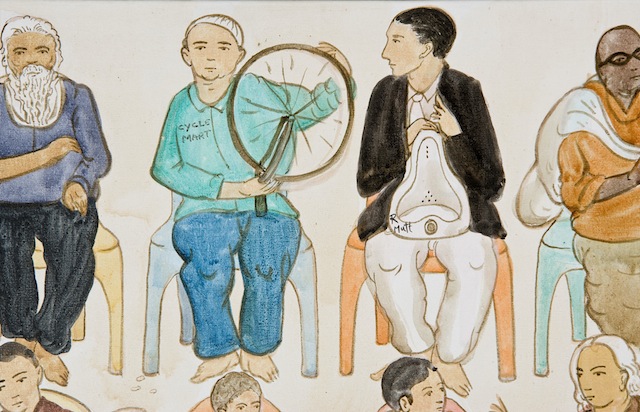
N. S. Harsha, Come Give Us a Speech (detail), 2008, acrylic on canvas, 183 x 183 cm (x6). Courtesy the artist and Mori Art Museum, Tokyo
N.S. Harsha, Mori Art Museum, Tokyo, through 11 June
If museums represent some sort of spiritual highpoint for Kim, then N.S. Harsha takes things to a whole other level (and let’s face it, someone always will): the Indian artist uses working temples as museums. Cosmic Orphans, his site-specific painting for the 2006 Singapore Biennale featured a series of sleeping figures and occupied the city-state’s Sri Krishnan Temple. Over in Tokyo, however, Harsha is having to make do with the Mori Art Museum, which hosts Charming Journey, his first major solo exhibition. The show features 70 major works created in a variety of media since 1995 and showcases the artist’s critical eye for the absurd in clashes between tradition and modernity, and nature and culture that feature in his immediate surroundings in South India, and more generally in the world at large. The installation Nations (2007), for example, features 192 antique-looking sewing machines, each of which features a painted calico flag representing one of the member states of the United Nations. The sewing machines are connected by a web of coloured threads, and each bears the legend ‘Made in the People’s Republic of China’. The work as a whole speaks of issues such as nationalism, internationalism, migration, globalism and the outsourcing and exploitation of labour. And if exploring and sometimes ridiculing notions of ‘development’ is one of Harsha’s key themes, it will only be given added poignancy for being exhibited in a museum founded by one of Japan’s most powerful property developers. Given your current state of enlightenment, you’ll be utterly unsurprised to learn that Charming Journey will feature yoga workshops. And that has nothing to do with cultural stereotypes. Harsha is a native of Mysore, a city that, since ancient times, has been famed for a school of painting (which remains Harsha’s medium of choice) specialised in delicate representations of the divine body.

The National: New Australian Art, MCA Australia, Sydney, 30 March – 18 June; Art Gallery of New South Wales, Sydney, 30 March – 16 July; Carriageworks, Sydney, 30 March – 25 June
Everything runs the opposite way Down Under. Which, presumably, is why, when almost every other art institution is attempting to demonstrate a global outlook (granted, in many cases this is linked to the globalised nature of finance), Sydney’s Museum of Contemporary Art Australia, together with the Art Gallery of New South Wales and Carriageworks, is putting on The National, which draws together work by artists who are based in Australia as well as Australian artists based overseas. You’ve got to have rules, right? And so, in nineteenth-century Great Exhibition-style, the survey, which seems to dance on the freshly filled grave of globalisation, billing itself, with rather too many qualifications, as ‘the only large-scale recurring exhibition in the city focused solely on contemporary Australian art’, is delivered with the usual promises regarding ‘the latest ideas and forms’. Given that there are around 50 artists taking part in the first edition of this sampling exercise, you wonder whether any Australian artists will have been left out by the time the saga comes to an end in 2021. Still, Australians – if you don’t know who you are, you will soon. That’s what art’s for, right? Holding a mirror up to society.

Stretched Terrains, Kiran Nadar Museum of Art, New Delhi, through 31 July
‘I would like you to take an aspirin before you see this film. It will surely give you a headache.’ That’s how Jehangir Jean Bhownagary introduced Akbar Padamsee’s 16mm animation Syzygy when it was released in 1969. ‘It depressed me to hear that,’ the artist recalls. ‘After that, I decided not to bother screening any of my films.’ Thank God then that Kiran Nadar does. Syzygy, along with Ashim Ahluwalia’s brilliant collaborative reconstruction of Padamsee’s lost second film, Events in a Cloud Chamber (1974/2016), are on show as part of the Kiran Nadar Museum of Art’s Stretched Terrains, a sprawling survey of postwar Indian art. The adjective ‘sprawling’ might not do this show justice, however. The museum itself bills the experience as being one of seven separate but interconnected exhibitions, each of which features work that unravels or comes to terms with the impact of Modernism in the Indian context (although the museum’s rhetoric, like its curatorial concept, is rather more baroque than that: in one sentence alone of its exhibition briefing we are asked to imagine the show as a multitude of landforms, a collection of parables and a rewinding, excavation and reexamination of a set of enquiries – now you understand where all ArtReview Asia’s punya goes). Among them are solo outings for the big guns of the Progressive Artists Group – M.F. Hussein, F.N. Souza and S.H. Raza, who died last year – as well as Interpositions: Replaying the Inventory, which includes more-recent work by Pushpamala and Mithu Sen. There is, of course, an element of nation-building and nationalism to the show with which our Australian friends might empathise, yet what’s on show here provides a rich – if sometimes labyrinthine – journey through Indian contemporary art. The highlight, of course, being the small exhibition focused on the activities of Padamsee (who up to that point was known as a precocious painter) and the Vision Exchange Workshop (VIEW) that he founded and which ran in Bombay between 1969 and 1972.
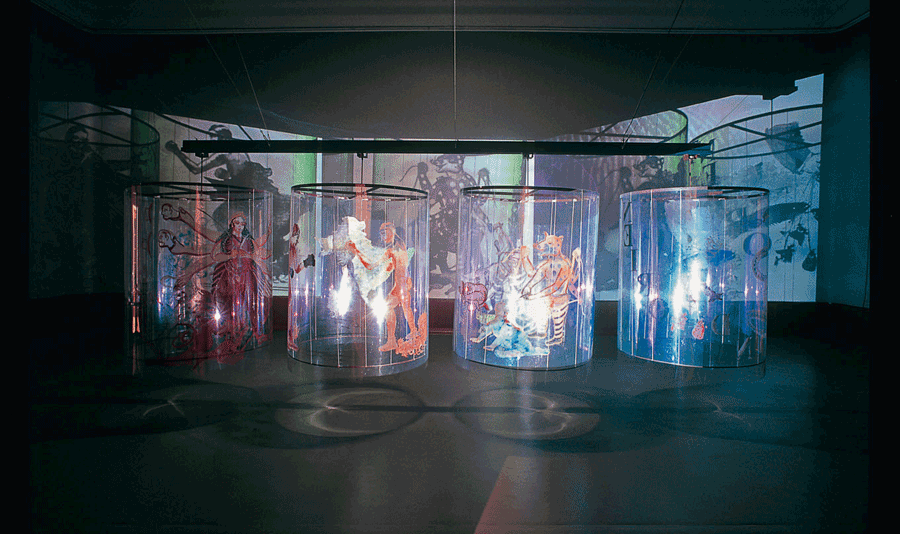
Nalini Malani, Stedelijk Museum, Amsterdam, 18 March – 18 June
One of the key participants in VIEW was Nalini Malani, and while Kiran Nadar shows a selection of her photograms and extraordinary films from that time, the Stedelijk Museum in Amsterdam will trace the development of her art, which also spans painting, theatre and installation, from those experimental works of the 1960s and 70s through to her output today. At the heart of it all is Transgressions (2001), an installation (after which the exhibition is titled) that combines painting, video and the moving shadow theatre that has characterised Malani’s later work, in order to investigate issues such as feminism and the role of women in society, Indian identity, modernity and its relation to the world outside it (and with Pakistan in particular: Malani was born in Karachi and, as an infant, exiled during Partition). For the Stedelijk, the exhibition is the first of seven collection-focused shows highlighting the issue of migration. For the artist, though, creating a work is like creating life: ‘The medium of video/shadow play is used in a manner that the artwork forms before one’s eyes,’ she whispered to The Brooklyn Rail four years ago. ‘It gets completed in your presence and immediately changes. As such no moment of the artwork is repeated. It is like life, in that one unique moment will never come back again. It grows and dies in front of you while you are part of the artwork itself.’ A good introduction then to one of the most innovative and important contemporary artists to come out of the subcontinent, and a timely one too. This October Malani will become the first Indian artist to have a retrospective at the Centre Pompidou in Paris.
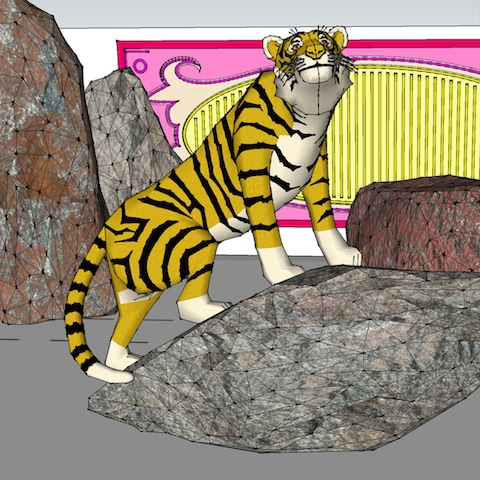
Adrian Wong, K11 Art Foundation chi art space, Hong Kong, 20 March – 29 April
Originally trained as a research psychologist, Chicago-born, Hong Kong-based Adrian Wong is another purveyor of largescale multisensory installations, and while Art Basel Hong Kong bigs-up the city as a global centre for culture and the commerce that now attends it, Wong will be busily taking those same aspirations apart in a new installation presented by the K11 Art Foundation titled The Tiger Returns to the Mountain. Rather than referencing a powerful Qi Gong practice, the work is centred on a concrete tiger, reminiscent of a sculpture that once stood in the Tiger Balm Garden, a complex built in Hong Kong in 1935 by Aw Boon Haw, inventor of the famous ointment (he also had mansions in Singapore and Fujian province). When it opened to the public during the early 1950s, it was as one of the first themeparks in Hong Kong. The statues then evolved into rides, and by the early 2000s the whole thing had been sold to property developers to be recycled as luxury housing. Fairground references aside, Wong’s installation is arranged like a traditional Chinese garden and evokes traditional philosophies of landscape and ink painting as well as the tiger as a Taoist symbol of power, all in aid of documenting Hong Kong’s struggles to find its postcolonial feet. ArtReview Asia fondly remembers drinking a vodka, duck fat, sugar and bok-choy cocktail while an automated mutant-muppet banged the drums at Wong’s Wun Dun art bar a few years ago, and comes to this latest display with high hopes of another immersion into the artist’s provocative world of the weird.
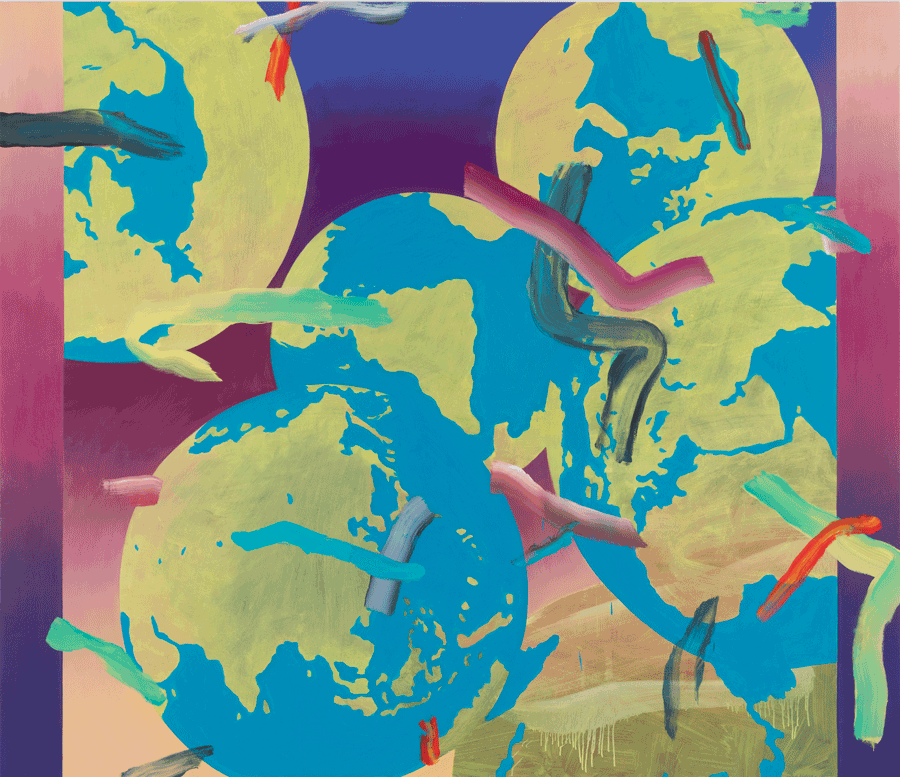
.com/.cn, K11 Art Foundation Pop-up Space, Sheung Wan, Hong Kong, 21 March – 30 April
Not content with that, K11 is also hosting a pop-up space showcasing .com/.cn, a group exhibition, staged as part of the foundation’s ongoing research collaboration with New York’s MoMA PS1, that looks at the potential for regional difference within the universal fog of digital cloud-culture. Ironically, then, for a show that is balanced on a partnership bridging East and West, its focus will be another slow tango over neoliberal globalism’s shallow grave: what a twisted world we live in. Naturally, work by China’s multimedia maven Cao Fei and New York collective DIS will be present; arguably less naturally, the show, curated by PS1’s Klaus Biesenbach and Peter Eleey, will feature paintings by the likes of American Laura Owens.

Park, Guangzhou, Holly’s Gallery, Guangzhou, 15 March – 16 April
For a more straightforward celebration of international relations, look no further than Park, a two-part encounter between artists from Dublin’s Kerlin Gallery and Holly’s Gallery, Guangzhou – in whose space one part of the show is located. The other part is a pop-up in Hong Kong. Look out for sculptures by Liam Gillick and Isobel Nolan, as well as paintings by Merlin James and Liliane Tomasko.
Zhou Li at Yuz Museum, Shanghai, through 4 June
New paintings by Sean Scully are matched by new works by Liu Ke, while Zhou Li contributes two mixed-media works and is also the subject of her first solo museum show in a decade, Shadow of the Wind, over at Shanghai’s Yuz Museum. That show comprises a survey of the Shenzhen-based artist’s abstract paintings, which seek to harness and then project the powers of the inner self. The end results rest somewhere between the abstractions of Cy Twombly and those of Zhang Enli.
This is Part I of ‘Previews’, from ArtReview Asia Spring 2017. Part II next week…
